She Convinced a Community to Love a 'Bad Omen'
An Indian biologist went door-to-door, listening and helping people develop livelihoods, to ultimately save an endangered species.
In January 2019, graduate student Tracy Melvin traveled from Michigan State University to India to attend an annual meeting of the Women in Nature Network, a loose collection of female conservationists from around the world. The trip required multiple flights and many hours of travel, but Melvin was eager to join in on conversations about the successes and struggles of conservation projects in a supportive environment.
As the conference began, Melvin says, she was impressed to hear what women were accomplishing, especially in low-income countries. But she was particularly interested when the host of the meeting, Purnima Devi Barman, got up to speak about her work with a gangly and obscure stork called the greater adjutant (Leptoptilos dubius). Once close to extinction, the bird has rebounded in Barman’s home state of Assam in northeastern India. And that success, according to widespread consensus, is primarily because of Barman, who has single-handedly transformed the species from a reviled nuisance to a beloved cohabitant among a surprisingly broad cross-section of people, including government officials, mothers, and people who pick through garbage dumps for a living.
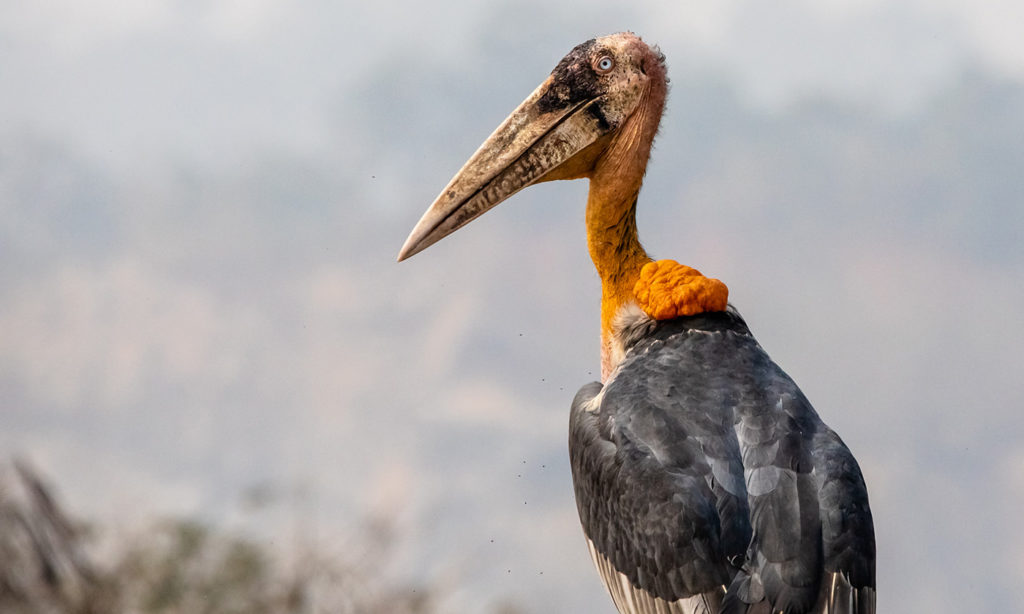
An endangered greater adjutant is pictured among the garbage in the Boragaon landfill in Guwahati, Assam, India. The landfill has the largest year-round concentration of the species in the world and has become an important nontraditional habitat.
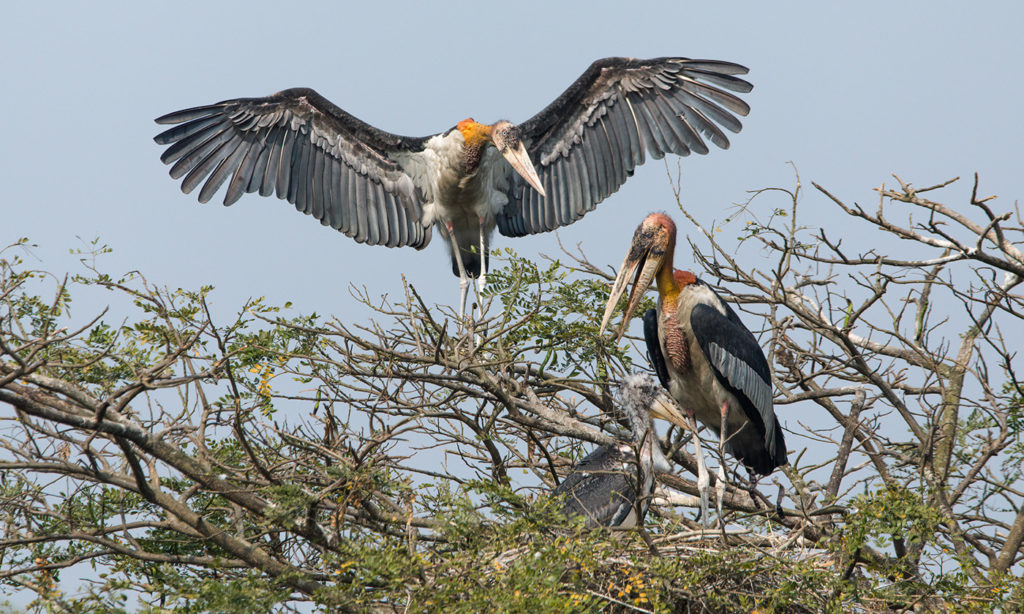
Adult greater adjutants perch next to their lone nestling. Villagers of the Kamrup district now protect the storks’ nesting trees, which are often in their backyards.
Hearing Barman talk made Melvin want to get involved—an effect Barman seems to have on people. More than a year later, the two women and several colleagues published a paper that looked at how community involvement has helped conservation of the striking storks. Among her most successful strategies, Barman has created an “army” of women who care for injured storks, throw celebratory baby showers for the birds, and weave stork-adorned fabrics for sale.
In contrast with decades of top-down and high-cost conservation efforts, experts say, the driving principle behind Barman’s work is deceptively simple: Saving species requires buy-in from people. Women, in particular, can be powerful partners, even—or especially—when they don’t hold traditional forms of power in their cultures. By including women in conservation projects that have simultaneously changed their own lives, Barman’s work may hold implications for similar efforts everywhere.
“She not only brought the species back from the brink, but she empowered women in a way that they probably hadn’t been empowered before,” Melvin says. “She’s not just helping the birds. She’s also helping the people. She’s giving them something to care about.”
Gathering Women
The greater adjutant is not a traditionally beautiful animal, and its lifestyle isn’t pretty either. A member of the stork family, it has skinny, knob-kneed legs, a relatively puny bald head, beady eyes, and an elongated orange pouch that hangs from its neck like a deflated balloon. It is awkward and large, standing about 5 feet tall. It is also notable for its smell. Traditionally called hargilas, which means “bone-swallowers,” greater adjutants drag dead carcasses into treetops, where they eat the flesh and then drop stinky messes of poop onto the ground below. The birds also spend a lot of time in garbage dumps, where they scavenge for food.
In the late 1800s, hundreds of thousands of greater adjutants lived in wetlands across much of Asia, from Pakistan to Cambodia. But habitat destruction, pollution, poaching, and the loss of their nesting trees pushed numbers sharply downward in the first half of the 20th century. A reputation as a bad omen in many places didn’t help them in the face of these threats. By the 1990s, there were an estimated 400 birds left. They have rebounded somewhat since but the International Union for Conservation of Nature still classifies them as Endangered, with only 1,200 to 1,800 birds confined to Cambodia and two regions of India—Bihar and Assam, where Barman lives.
Despite the longstanding cultural disgust that surrounded the birds, Barman quickly began to appreciate the storks’ more appealing side. Raised for several years by her grandmother, who often took her outside and taught her songs and stories about birds, she developed a connection with nature that brought her solace during a period when her parents were away. Later, she studied zoology and wildlife biology at Gauhati University, where she earned an undergraduate degree and then a master’s in 2002. Eager to pursue a Ph.D., she gave in first to family pressures to get married and have children, giving birth to her twin daughters in 2005. She started her doctorate work in 2007, with a focus on greater adjutants.
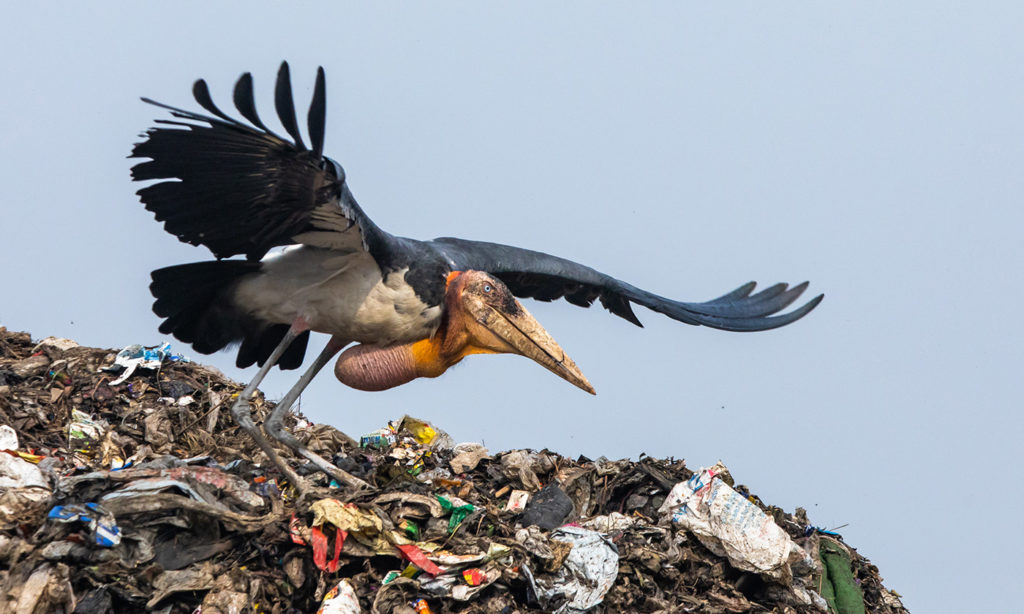
Of the world’s 19 species of storks, the greater adjutant is the most endangered in the world. In 2016, the International Union for Conservation of Nature estimated the global population at just 800 to 1200.
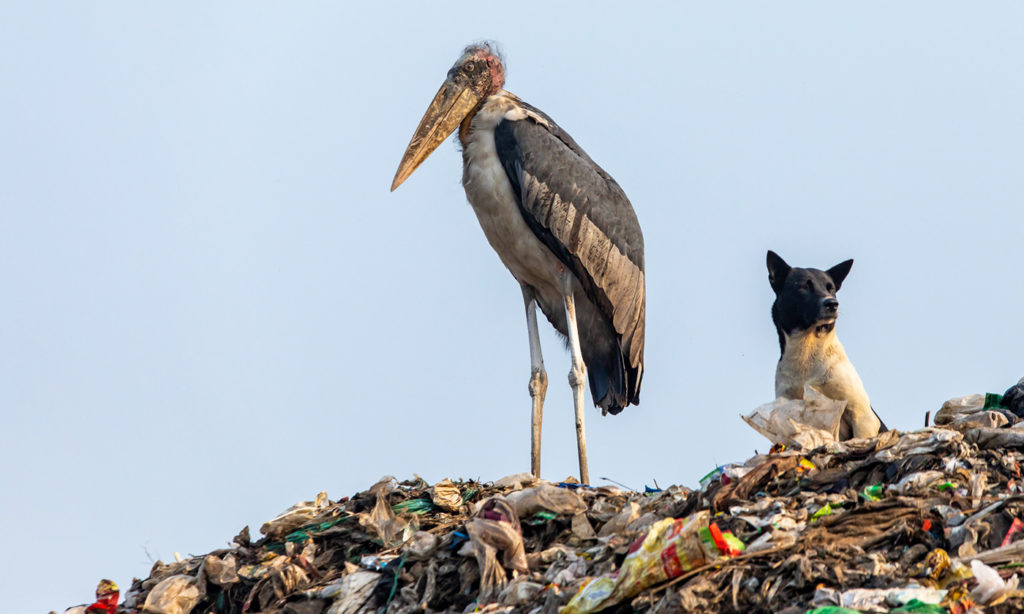
An endangered greater adjutant is seen here next to a stray dog in the Boragaon landfill in Guwahati, Assam, India.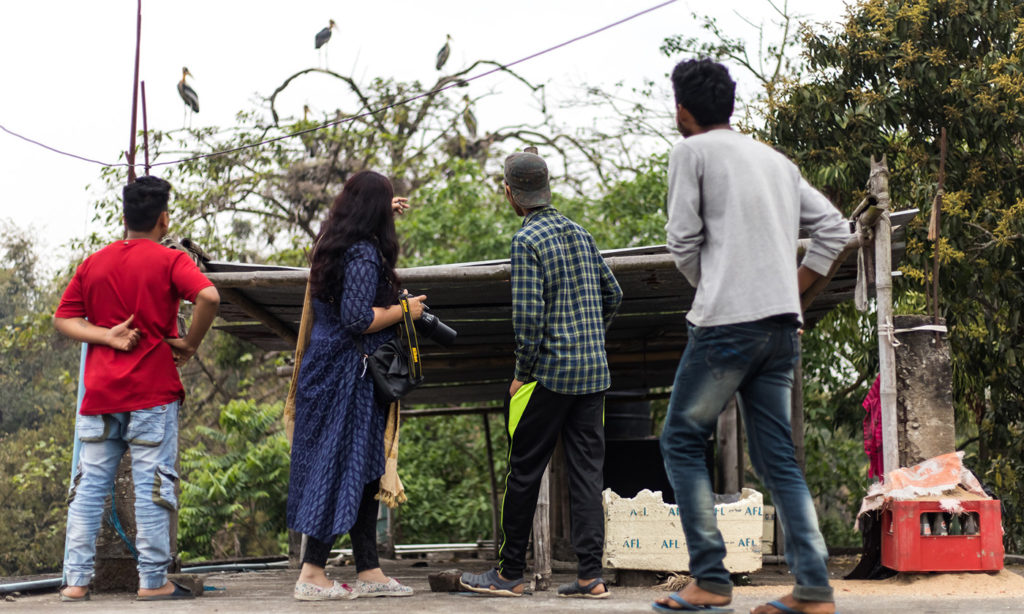 Biologist Purnima Devi Barman and team members observe nesting greater adjutants, which have chosen to nest in a “hargila army” member’s backyard.
Biologist Purnima Devi Barman and team members observe nesting greater adjutants, which have chosen to nest in a “hargila army” member’s backyard.
Aware of the outsized conservation attention that goes to India’s charismatic megafauna like rhinos (Rhinoceros unicornis) and tigers (Panthera tigris tigris), Barman had started thinking about studying hargilas when she saw them in a wetland while doing fieldwork for her Masters. Why, she wondered, had she never seen them in her own village? As she began to collect data, she visited the few villages where they did live. While there, she would leave her phone number so people could call her if they had anything to report about the birds. One day at the end of the hargila breeding season in 2007, she got a call. A villager In the Kamrup district had cut down a giant tree on his property. The tree contained nine nests, filled with hargila nestlings.
Once at the scene, people gathered around and laughed at her. They jeered and teased her about her concerns. They were angry and mean. “Why are you lecturing us?” they asked her. Why should we care about such an ugly bird? Would she pay them to care? Would she come live with them and clean up after the birds? Would she eat the birds on her way home?
Trembling with embarrassment and dismay, Barman thought about her daughters, then just 2 years old. On the way home, she made a decision to delay her Ph.D. work. “I thought, ‘No, I won’t do it now,’” she says. “‘First, I’ll rope in all the people. I’ll win the hearts and minds of the people. We will start a people’s movement. And then, only if I’m successful with the birds, I’ll pursue my dream.”
Her plan was to start with the basics: Meet people. Build friendships. Try to understand community concerns. Remembering the comments from men in the village, she cleaned temples to earn trust and show she was listening. Her compassion ran deep. She recognized that these weren’t bad people. They thought they were doing the right thing: ridding themselves and their properties of a messy bird that was a bad omen. It wasn’t their fault that they thought poorly of hargilas. They just hadn’t learned about the value of wildlife.
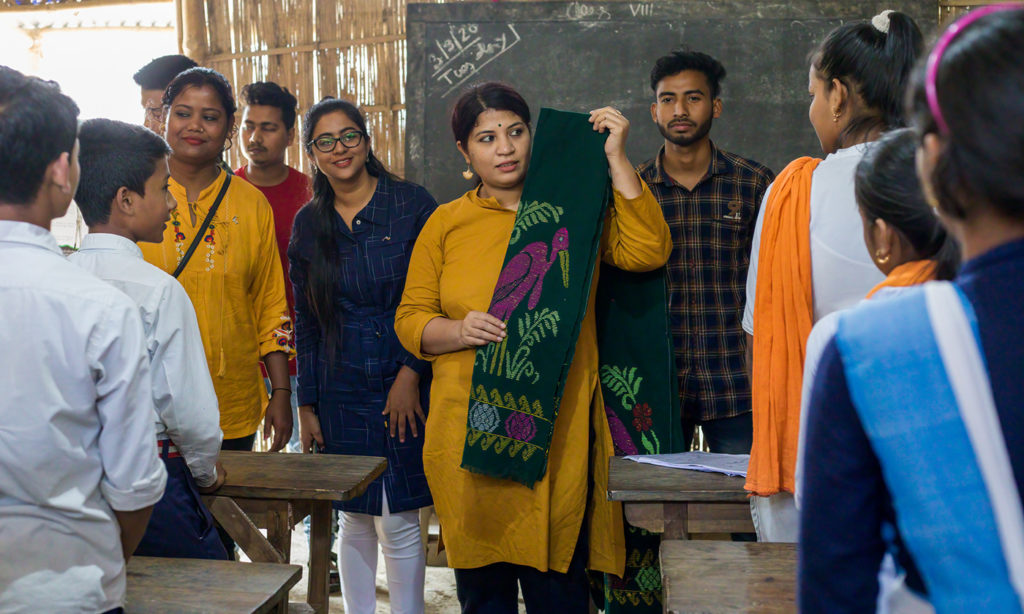
During school visits, students refer to Purnima Barman as “Hargila Baideo,” which translates to “elder sister of greater adjutants.”
Soon, Barman’s work coalesced around a single, if improbable, goal: Get people in the villages of Assam to incorporate the greater adjutant into their local culture and traditions. Because the birds spent much of the year nesting in trees on private property, she knew they were untouchable by government protections. Her only hope was to make people care about the birds like they care about their own children. That way, they wouldn’t want to cut down the trees anymore.
In 2009, Barman organized the first of what would become many hargila “baby showers.” She invited about 30 women for the event, and she made the celebration as traditional as possible. It included prayer songs, a cooking competition, and games that incorporated lessons about wildlife. Barman talked to the women about the birds and how vulnerable they are during the breeding season. She appealed to their identities as mothers, comparing the birds to women when they give birth. Acceptance came quickly, Barman says, and the popularity of the baby showers snowballed into a coalition of women who rallied behind the storks. Barman started to think of them as a “hargila family.” In 2014, she dubbed them the “hargila army.”

Educational programs at local schools are key to Barman’s conservation efforts. In her mind, if students are taught at a young age to love and respect greater adjutants, the species will have allies in the future.
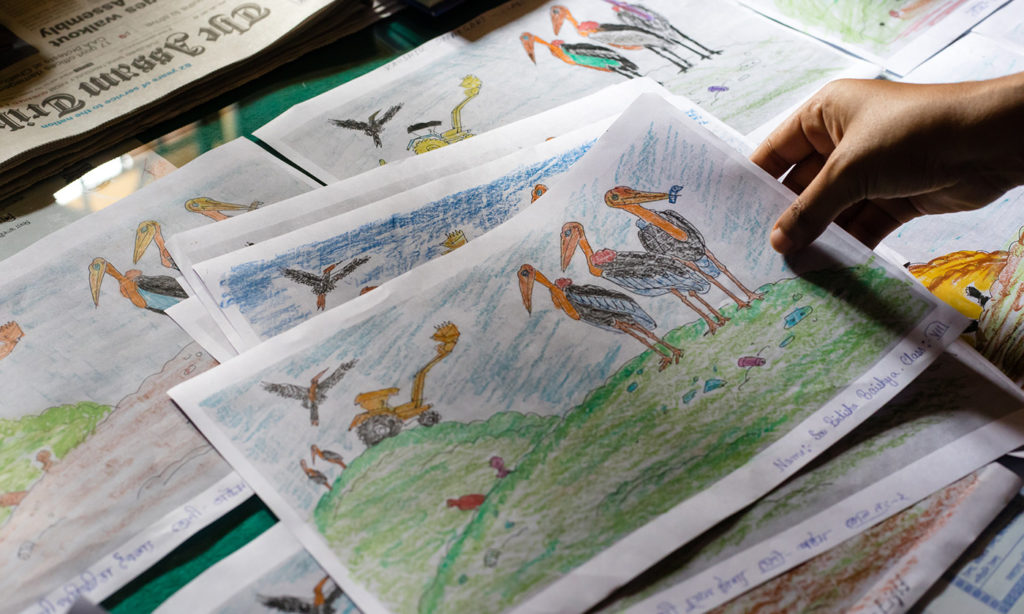
Students are provided with coloring pages featuring endangered greater adjutants as a means of educating and inspiring local wildlife conservation efforts.
Since then, the army has helped rehabilitate injured birds. Using looms and yarn distributed by Barman, women have also started to weave traditional fabrics adorned with storks, which they sell to help support their families. More than 400 women take part in the conservation work on a daily basis, Barman says. More than 10,000 women and their families have participated in hargila-related activities.
With Barman’s guidance over the past decade, the stork has become a symbol and way of life, says Ana Liz Flores, a conservationist and senior adviser for the LAC-Huairou Commission, a grassroots NGO in Argentina. Like Melvin, Flores attended the WiNN meeting in India in 2019. While she was there, she visited several villages, where it was clear to her that hargilas had become integral to the community’s identity. Women and children were leading the effort. “The schools and the women are the key pieces of the whole project,” she says. “It’s the first time I have seen a community that involved with one species. That, to me, is special.”
Barman has faced plenty of gender discrimination in her career, she says, and women in her culture are not usually included in decision-making. But women have power in their households, and by reaching them, she has been able to reach their children, relatives, and entire communities. “They are rural women. They are the homemakers,” Barman says. “I think the world should know about this huge force of women.”
Contagious Obsession
By the time the Women in Nature Network conference came to Barman’s hometown in early 2019, she had transformed the greater adjutant’s prospects. Not only has the number of storks in the villages of Assam more than doubled since she began her work, from 400 birds to as many as 1,200 (of which 800 are mature), numbers of nests have grown nearly tenfold, from 27 to 215 in the villages where she has focused her efforts. And there are signs of population growth to come. Not a single nesting tree has been cut down since 2010, Barman says. One colony is producing about 85 juvenile birds a year, half of which survive. And her conservation work has also expanded to include an assisted breeding program that is beginning to show results. After not producing any viable birds during its launch year in 2017, the program released one fledgling in 2019 and five in 2020.
As Barman’s successes have accumulated, she has been able to tell an ever-growing audience about what she has been up to, and Melvin isn’t the only person who has been captivated by the biologist and her work. Another enthusiast is Carla Rhodes, a longtime comedienne and ventriloquist from New York who had recently picked up wildlife photography and developed her own obsession with greater adjutants when she got an unexpected call from a friend in the summer of 2018. The friend was a producer working on a TV pilot for a show called “Rickshaw Run,” which sends people out to navigate some of the most dangerous roads in the world in motorized rickshaws. The next season would soon be filming in India, he told her, and a participant had dropped out of the show at the last minute. Would Rhodes consider going in his place?
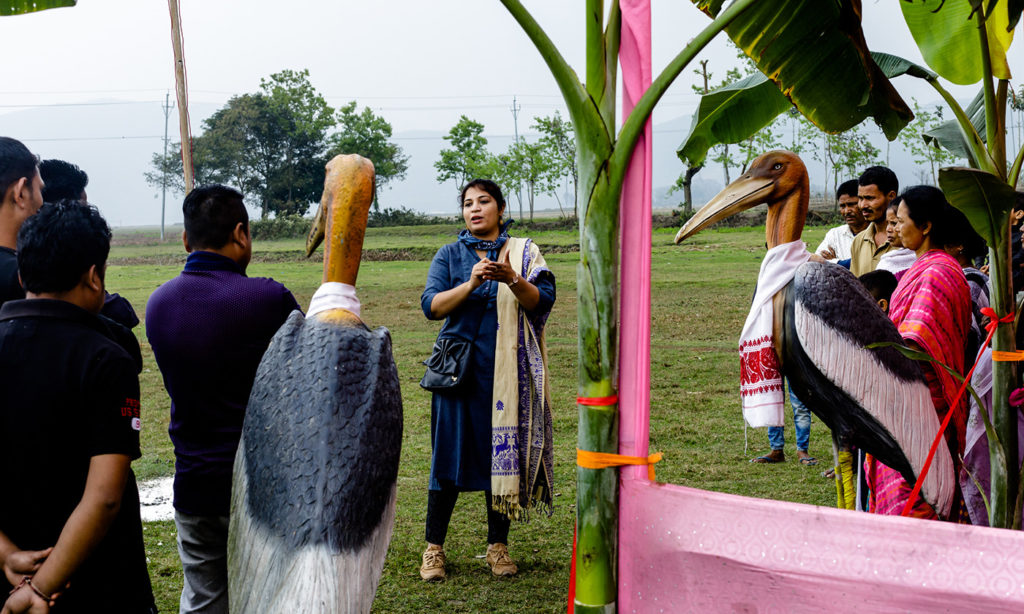
Biologist Purnima Devi Barman is pictured speaking to villagers and members of the “hargila army” at a cricket match organized to raise awareness and educate locals about greater adjutant conservation efforts.

Jonali, a member of the “hargila army,” sews a tote bag with an embroidered greater adjutant motif to help combat plastic bag usage. Members of the hargila army take great pride in protecting this endangered species.
Rhodes said yes, if only to get to India where she planned to stay after the filming so she could take photographs. She flew out that September and after surviving the rickshaw adventure, she went to Manas National Park in Assam. It was the rainy season in India, and the park was one of the few in the country that was accessible. She had an incredible experience in the park, where she took pictures of elephants (Elephas maximus indicus), rhinos, capped langurs (Trachypithecus pileatus), and more. Then, on the drive back to Guwahati, Assam’s hub town, she spotted a giant, blue-eyed, dinosaurlike bird standing by a rice field on the side of the road. She asked her driver to stop. He told her it was an endangered greater adjutant and offered to show her more on their way back to Guwahati.
Expecting to be taken to a wetland, Rhodes was surprised when the car pulled up at an enormous, sprawling garbage dump. Hargilas stood on mountains of trash alongside cows, soiled white egrets, and garbage-pickers—people who make money by rummaging through the landfill. The temperature was stiflingly hot, and the smell reminded Rhodes of New York City on garbage day in the summer—multiplied by 100. The scene was both postapocalyptic and beautiful, and although she had to fly home the next day, she felt transformed. “I was only there for about 20 minutes, but it just moved me and shook me to the core of my being,” she says. “It was at that moment I decided I don’t want to be a wildlife photographer. I want to be a wildlife conservation photographer.”
Determined to find a way back to India and the birds, Rhodes began researching as soon as she returned home to Brooklyn. She learned about Barman, who she contacted by email in early 2019, around the time of the WiNN meeting there. Drawn in by the contagious nature of Barman’s single-minded passion, she was soon offering to help. With a small grant from WiNN, Rhodes returned to Assam for five weeks in February and March 2020—just before the world shut down because of COVID-19.
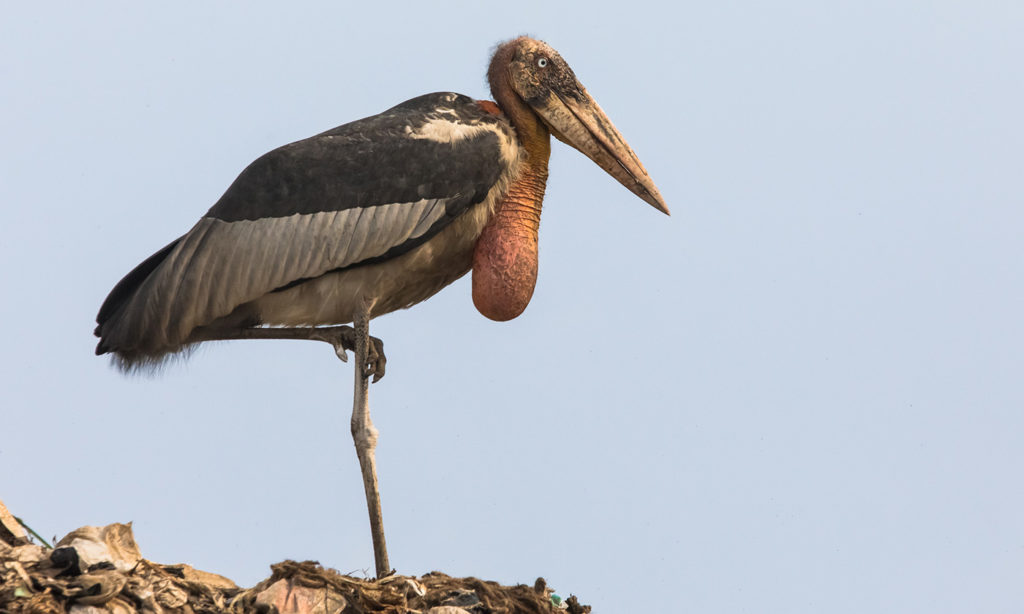
An endangered greater adjutant stands on garbage in the Boragaon landfill.
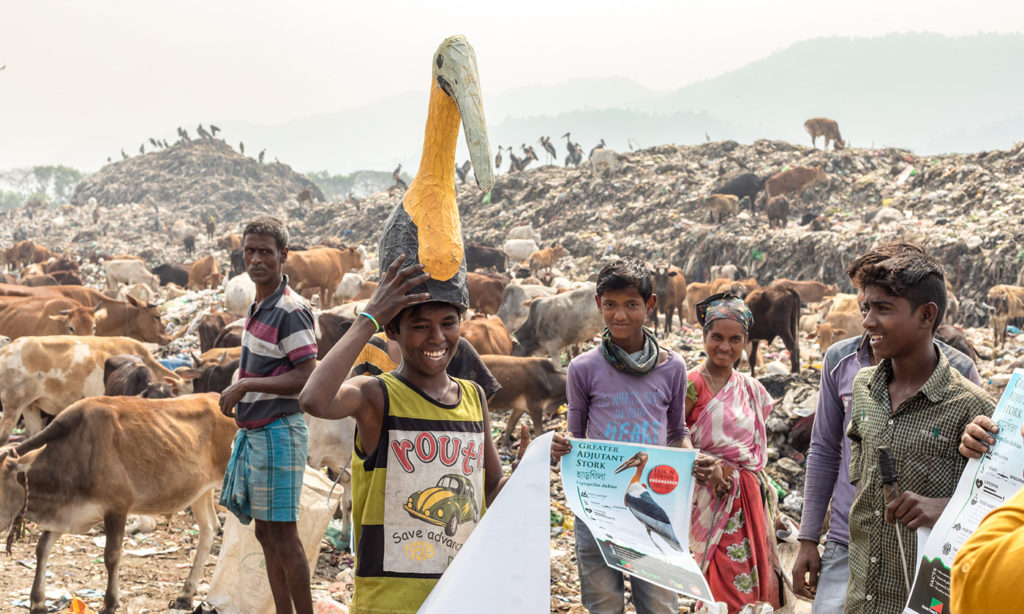
Migrant “rag-pickers” live and sort garbage in the Boragaon landfill where a large population of greater adjutants scavenges beside them.
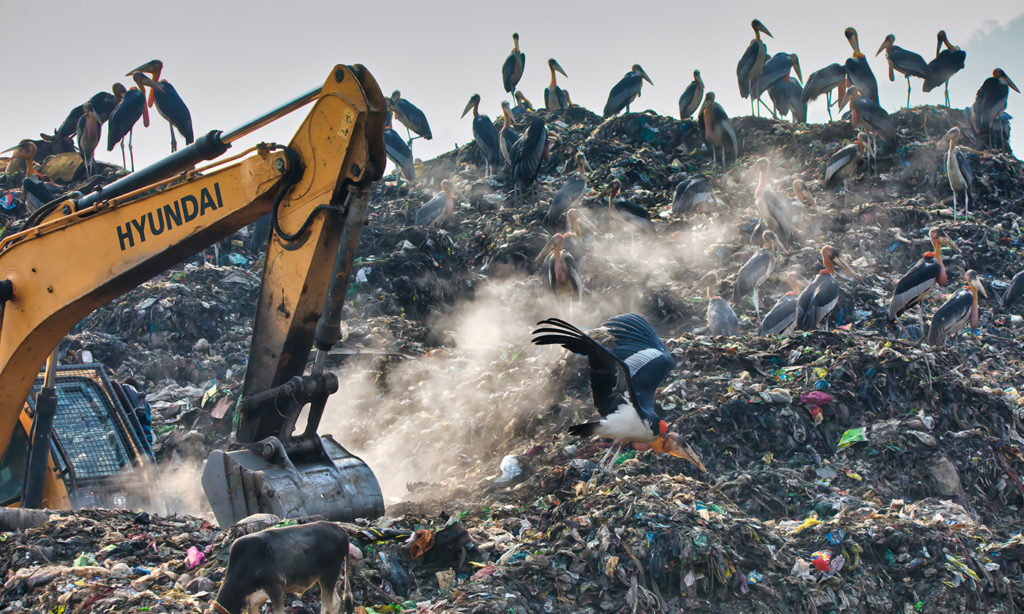
Attracting a variety of scavenger species such as this flock of greater adjutants and encroaching upon the Deepor Beel Wetland, the Boragaon landfill is a prime cause of pollution, habitat destruction, and wildlife deaths through poisoning.
Even though Rhodes was a stranger, Barman invited her to stay in her home, where she lives with her biologist husband and two now-teenage daughters. Rhodes spent those weeks following Barman everywhere. They went to the market, where the conservationist stuffed her cloth bag to the brim with vegetables, refusing to use plastic. They went to schools and villages, where people treated Barman like a celebrity. Rhodes even attended a wedding with Barman, who somehow convinced the couple to adorn their ceremony with statues of hargilas and to paint images of the birds on guests’ hands with henna.
Rhodes repeatedly marveled at how much influence Barman had on just about everyone, including the police. If someone reports an injured hargila, officers help them transport the birds to zoos for rehab. “You call the police about an injured animal in my area, they’re like, ‘We can’t do anything,’” Rhodes says. Barman’s group is also working with government officials to build nets under trees to catch any nestlings that fall.
Watching Barman at work, Rhodes could see that Barman was why the storks were thriving in a community that had had once hated the birds. Rhodes took thousands of photos, some of them featured in this story. “I thought it would just be like, you’d see a hargila here, you’d see one there. But there are so many, it’s insane,” Rhodes says. “And she is responsible for bringing them back because she convinced people to take ownership of this bird—that it’s a privilege that this bird chose your tree to nest in, and to not cut these trees down.”
Nontraditional Habitats
Historically, greater adjutants thrived in the vast wetlands of India and beyond, where they fed on abandoned carcasses and nested in wild trees. As wetlands have disappeared and been paved over by development, the birds have shifted their habits, building nests in the village trees of Assam and eating in the nearby landfill. For Rhodes, the landfill offered striking imagery full of symbolism: birds scavenging alongside people on mountains of discarded items. For Barman, the garbage dump is just another place to spread the word about bird conservation. One day, Rhodes watched as Barman walked through the dump, talked with people, handed out posters, and gave sweets and coloring sheets to kids.
Biologists, too, have a growing interest in places like these—often overlooked habitats in urban landscapes, where wild animals are finding new ways to adapt. And dumps aren’t necessarily all bad, according to a 2017 review of 159 studies that looked at 98 species of birds, mammals, reptiles, and amphibians found on garbage dumps all over the world, especially in Europe, North America, and Africa.
The analysis turned up plenty of negative effects, including elevated risks of infection, poisoning, and human-animal conflicts in the dumps. According to a 2016 study of white storks, birds that fed in landfills were more likely to stick around throughout the year, drastically reducing their migratory range. Living around landfills also increases a stork’s chances of picking up an E. coli infection, according to a study published in 2020.
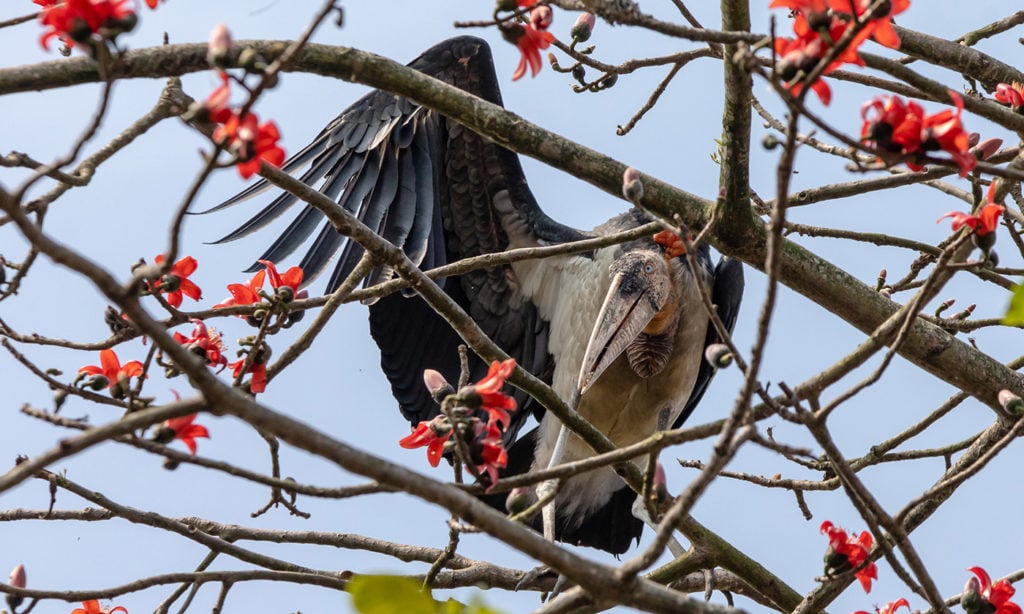
An endangered greater adjutant is pictured in a silk cotton tree. Since conservation efforts began in 2010, nesting trees have been preserved locally.
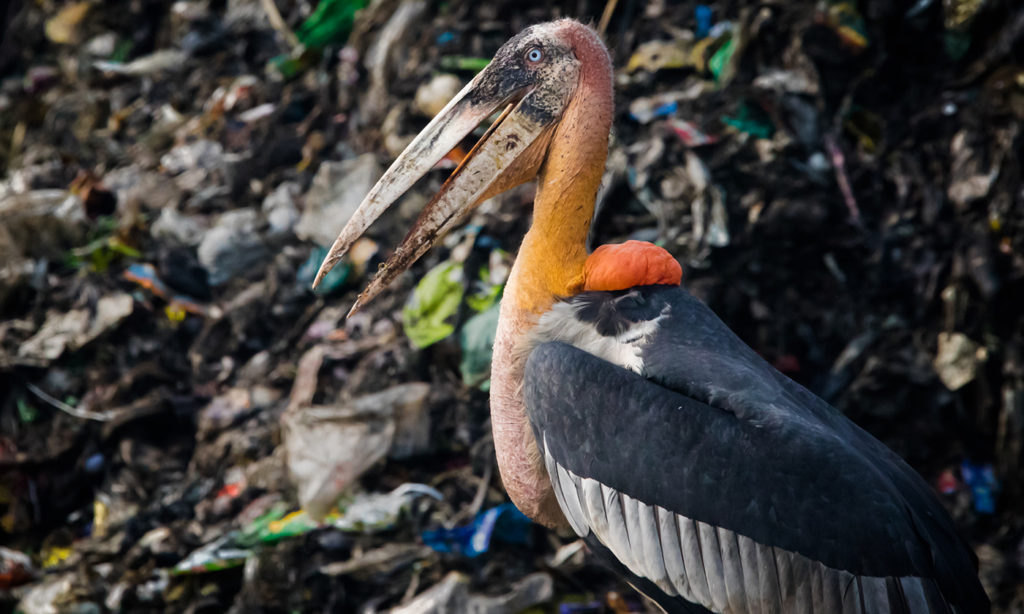
Once covering 9,884 acres, the wetland Deepor Beel has shrunk to an alarming 500 hectares because of habitat destruction and encroachment from the Boragaon landfill.
But dumps have also become important sources of food in changing environments. And compared to animals living in natural areas, the review found that polar bears, island foxes, bald eagles, and other creatures that fed in dumps did better than other individuals on a number of measures that included body condition, reproductive success, and survival. Among the effects that dumps had on various species, more than 70 percent were positive. In one study included in the review, dump-dwelling white storks produced more eggs compared to birds that didn’t have access to these food resources.
What rapid and urban development means for the future of any given species is still unclear. But acknowledging the hargila’s adaptability to a new kind of ecological landscape has the potential to highlight novel approaches to conservation into the 21st century, Melvin says, in part by helping people relate to species that live in their midst. “What’s so endearing about them is that they survived through habitat degradation, through illegal persecution, through everything. And they are just like, ‘Well, I’m going to eat in the dumps, and I’m fine with it.’ They’re a rugged, persistent thing,” she says, adding that there are parallels between the birds and the human garbage-pickers, who have also had to adapt to incredibly difficult circumstances. “They’re a remnant bird from this vast, once-functional landscape, and here they are. This is reality. This is what they’re dealing with now.”
Barman’s approach accepts the reality of the world as it is right now, Melvin says. Her work incorporates the idea that pristine wilderness is a false construct and that saving species requires involving the people who live alongside those species. It also illustrates how persistence and a focus on raising awareness can rapidly transform the way people think about animals: from reviled to adored in just a decade.
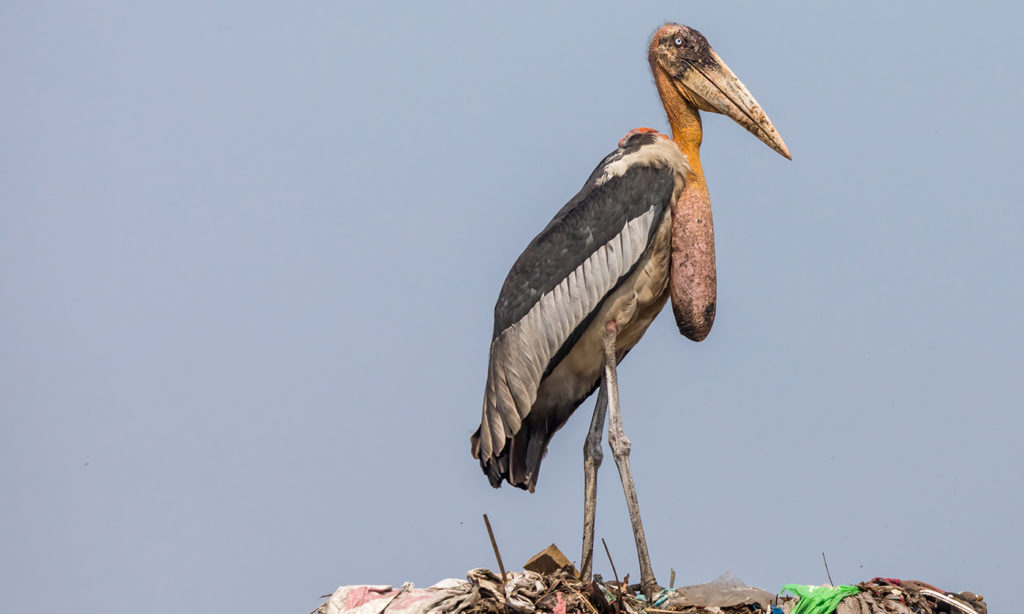
Providing both refuge and potential harm, landfills are emerging as complex ecosystems for many scavenger species, including greater adjutants.
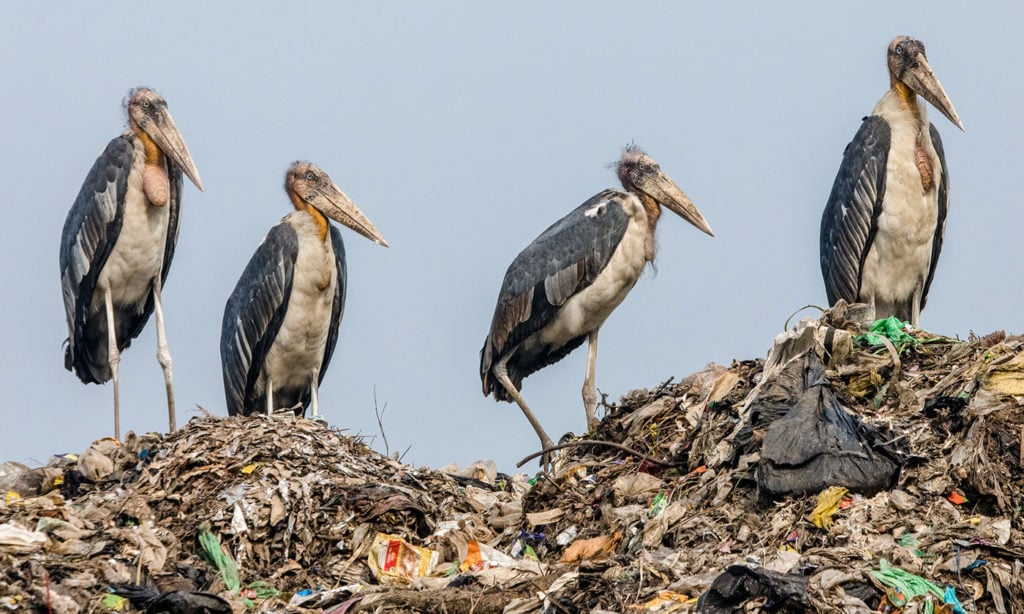
A muster of endangered greater adjutant storks stands atop a landfill.
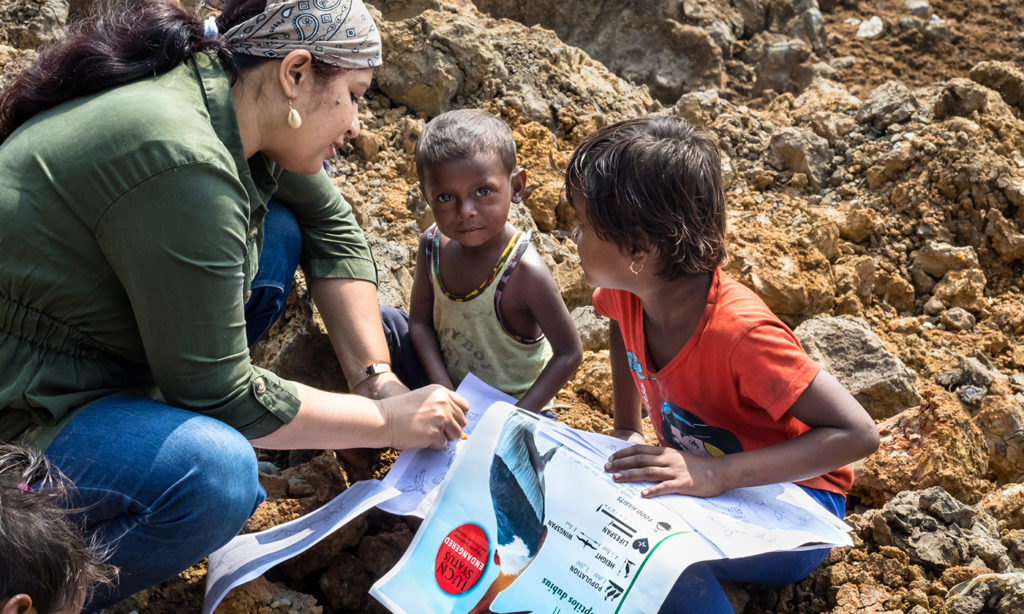
Purnima Devi Barman presents informational posters, coloring pages, and food to the people living and working in the sprawling landfill with the goal of raising awareness for the greater adjutants.
It’s hard to imagine ranchers in the American West adopting wolves as their mascots, but Barman’s work holds lessons for conservation projects around the world, Melvin adds. She made conservation mainstream from the bottom up—going door to door and person to person, hearing people out, helping people develop livelihoods, making it all happen without waiting for the government to take charge. Those are steps anyone could take anywhere. “It’s truly an example of how doing a small lift for people in their home countries can make conservation truly effective,” she says. “Maybe that’s what the world needs is people to just think less and do more.”
Enacting change doesn’t have to cost much, Flores says. With a clear objective and genuine connections, a lot can be done with a little for any species. Barman has made great strides with limited resources. “As a conservationist, I used to visit fantastic, very high-level projects in Africa and other places,” Flores says. “This is a simple community project, but everyone in the community is engaged. You can see the commitment in women and the kids. Everybody is very, very proud of having that project in the community. To me, that is amazing.”
For Barman, saving hargilas by involving women has been a personal mission as much as a professional one. When her daughters were little, she used to take them into the field, where they would stay with an assistant and watch as she climbed 85-foot trees to study the nesting birds before coming back down to feed her own kids. As her daughters grew, they began to accompany her on community outreach efforts. In 2018, they watched her finally achieve her dream of earning a Ph.D. “I think they saw all the struggles. I think that helped them to know the life, to know in depth about wildlife,” she says. “I tell them, ‘Every day your heart should be an environmentalist. Every day you wake up, you should live like an environmentalist. It doesn’t mean you have to be a biologist by profession. But every work you do, it should be for nature.’ And they agree. They really love it.”
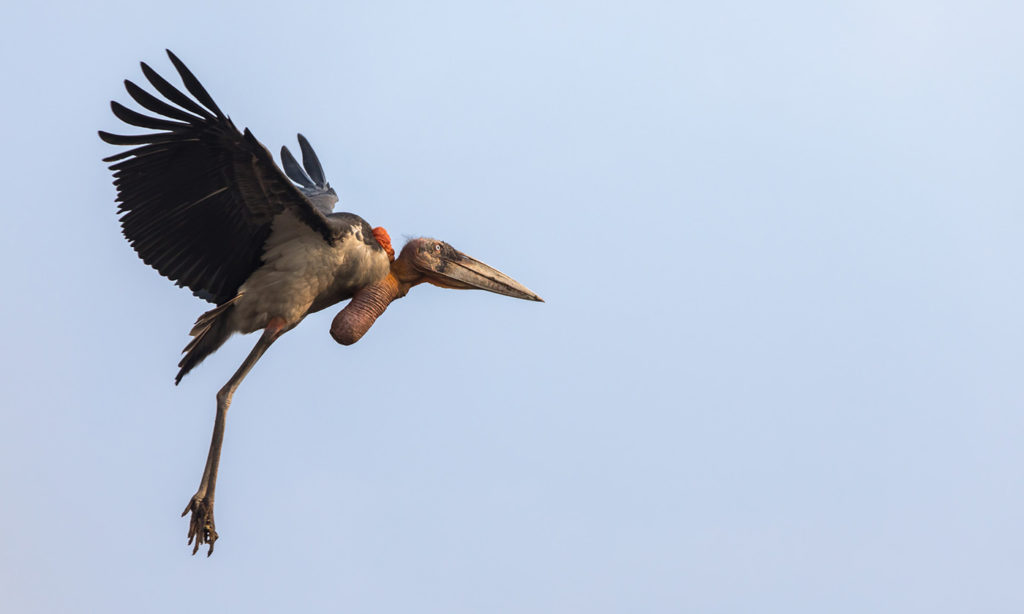
A greater adjutant in flight.
This story originally appeared in bioGraphic, an online magazine about nature and sustainability powered by the California Academy of Sciences. Emily Sohn is a freelance journalist in Minneapolis whose stories have appeared in National Geographic, Outside, The Washington Post, The New York Times, Nature, NPR, and many other publications. Read more of her work at www.tidepoolsinc.com


On Mar 19, 2021 Patrick Watters wrote:
If you teach even one other human being to love, you will effect all Creation. }:- a.m.
Post Your Reply